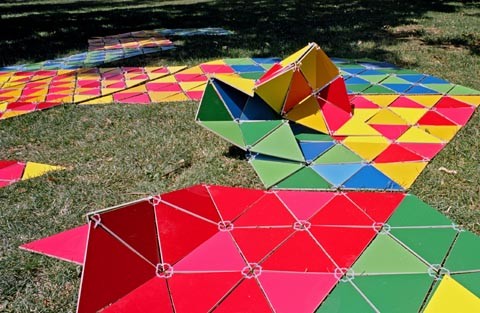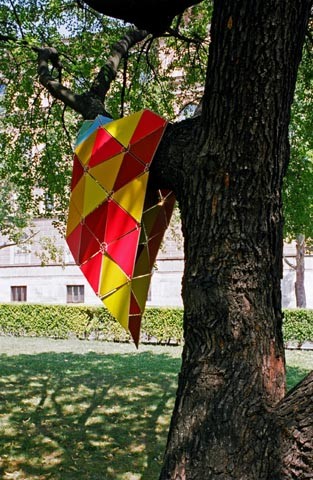Azra Akšamija
21 Jul - 30 Sep 2007
AZRA AKŠAMIJA
KUNSTMOSCHEE
July 21 – September 30, 2007
Secession Garden
In her work, the artist and architect of Bosnian origin Azra Akšamija examines Islamic architecture and religion, as well as current forms of religious practice and identity. Her projects show various states and needs of a cosmopolitan generation of Muslims who refer to the underlying traditions of form and function, but who apply them to a contemporary context. This analysis draws on different cultural traditions and forms of art and architecture. One example of this is her design for a “Dirndl mosque”, as well as her current project that refers to the art historical and architectural tradition of the Secession, whose structure and ornament she transforms.
KUNSTMOSCHEE is a multifunctional, three-dimensional landscape of carpets in the Secession garden that reinterprets the established forms of Islamic architecture and the representation of religious identities. At the same time, it subtly breaks down the territorial claims of sacred places: on the one hand, prayer turns the modular carpet landscape into a mosque; on the other, social functions and uses turn it into a meeting place and communication forum for persons with different cultural needs. In this way, the installation focuses attention on the wideranging possible uses of mosques between religious and secular functions, and thus on the mosque as a “social” location.
KUNSTMOSCHEE revolves around three main concepts: beauty – based on Islamic geometry as a spatial translation of Islamic theory; transformation – via the reinterpretation of the rules of historic mosque architecture in a contemporary context; and flexibility – seen as a modular set consisting of the elements structure, light and shadow, interacting with a particular usage of the space. This also refers to the variable typology of the mosque, which can and must adapt itself to the architectural and programmatic elements of building culture in different countries and cultures.
KUNSTMOSCHEE places the focus on the distorted and politicized representation of Islam in Europe, on the aesthetic of Islamic culture and its close historic links with the Christian/European aesthetic. The project will be accompanied by lectures and film evenings.
AZRA AKŠAMIJA, born 1976 in Sarajevo, Bosnia and Herzegovina, Austrian citizen since 1997, lives and works in Cambridge, USA.
SHOWS (selection): 2007 Pattern Language: Clothing as Communicator, Pail and Lulu Hilliard University Art Gallery, Louisiana, Los Angeles; 2006 Survival, Assembly #4, Joanneum, Graz; Pattern Language: Clothing as Communicator, Frederick R. Weisman Art Museum, Minneapolis, MN; Grenzräume, Galerie für zeitgenössische Kunst Leipzig; Lost Highway Expedition materials, Center for Advanced Visual Studies MIT, Cambridge, MA; The 2006 Harold and Arlene Schnitzer Prize in the Visual Arts Competition, Wiesner Student Art Gallery MIT; Mind the Gap, Smack Mellon Gallery DUMBO/NYC; 2005 International Artist Symposium ORTung, Galerie 5020, Salzburg; Occupying Space – Sammlung der Generali Foundation, Haus der Kunst, Munich/ Museum of Contemporary Art and Galerie Klovičevi dvori, Zagreb/ Witte de With, Rotterdam; 2004 Noch einen Wunsch, Galerie für zeitgenössische Kunst, Leipzig; Liverpool Biennale; Video-Pool, Austrian Cultural Forum, London; 2003 Medien- und Architekturbiennale Graz; micro-UTOPIAS, Art & Architecture, Valencia Biennale; 2002 Designs for The Real World, Generali Foundation, Vienna.
Concept, idea and design: Azra Akšamija
http://www.mit.edu/~azra/
Architecture and conceptual assistance: Heidi Pretterhofer (Arquitectos)
http://www.arquitectos.at/projekt01/index.php
Project coordination: Christina Nägele
Thanks to: The participants of the KUNSTMOSCHEE-programme; Nadja Akšamija, Omar Al-Rawi, Saeed Arida, Amina Baghajati, Patrick Baumüller and Severin Hofmann, Khadija Z. Carroll, Vivien Chapeau, [dy:na'mo], Wolfgang Haas, Mouhanad Khorchide, Daniela Kobel, Susan Kraupp, Anneka Lenssen, MA 42, Sudabeh Mortezai, Nasser Rabbat, Christian Rathner, Doris Schmid, Dieter Spath, Deniz Turker. The exhibition is kindly supported by The Council for the Arts/ MIT, Boston and Kodak.
www.mit.edu/~azra/Kunstmoschee.htm
KUNSTMOSCHEE
July 21 – September 30, 2007
Secession Garden
In her work, the artist and architect of Bosnian origin Azra Akšamija examines Islamic architecture and religion, as well as current forms of religious practice and identity. Her projects show various states and needs of a cosmopolitan generation of Muslims who refer to the underlying traditions of form and function, but who apply them to a contemporary context. This analysis draws on different cultural traditions and forms of art and architecture. One example of this is her design for a “Dirndl mosque”, as well as her current project that refers to the art historical and architectural tradition of the Secession, whose structure and ornament she transforms.
KUNSTMOSCHEE is a multifunctional, three-dimensional landscape of carpets in the Secession garden that reinterprets the established forms of Islamic architecture and the representation of religious identities. At the same time, it subtly breaks down the territorial claims of sacred places: on the one hand, prayer turns the modular carpet landscape into a mosque; on the other, social functions and uses turn it into a meeting place and communication forum for persons with different cultural needs. In this way, the installation focuses attention on the wideranging possible uses of mosques between religious and secular functions, and thus on the mosque as a “social” location.
KUNSTMOSCHEE revolves around three main concepts: beauty – based on Islamic geometry as a spatial translation of Islamic theory; transformation – via the reinterpretation of the rules of historic mosque architecture in a contemporary context; and flexibility – seen as a modular set consisting of the elements structure, light and shadow, interacting with a particular usage of the space. This also refers to the variable typology of the mosque, which can and must adapt itself to the architectural and programmatic elements of building culture in different countries and cultures.
KUNSTMOSCHEE places the focus on the distorted and politicized representation of Islam in Europe, on the aesthetic of Islamic culture and its close historic links with the Christian/European aesthetic. The project will be accompanied by lectures and film evenings.
AZRA AKŠAMIJA, born 1976 in Sarajevo, Bosnia and Herzegovina, Austrian citizen since 1997, lives and works in Cambridge, USA.
SHOWS (selection): 2007 Pattern Language: Clothing as Communicator, Pail and Lulu Hilliard University Art Gallery, Louisiana, Los Angeles; 2006 Survival, Assembly #4, Joanneum, Graz; Pattern Language: Clothing as Communicator, Frederick R. Weisman Art Museum, Minneapolis, MN; Grenzräume, Galerie für zeitgenössische Kunst Leipzig; Lost Highway Expedition materials, Center for Advanced Visual Studies MIT, Cambridge, MA; The 2006 Harold and Arlene Schnitzer Prize in the Visual Arts Competition, Wiesner Student Art Gallery MIT; Mind the Gap, Smack Mellon Gallery DUMBO/NYC; 2005 International Artist Symposium ORTung, Galerie 5020, Salzburg; Occupying Space – Sammlung der Generali Foundation, Haus der Kunst, Munich/ Museum of Contemporary Art and Galerie Klovičevi dvori, Zagreb/ Witte de With, Rotterdam; 2004 Noch einen Wunsch, Galerie für zeitgenössische Kunst, Leipzig; Liverpool Biennale; Video-Pool, Austrian Cultural Forum, London; 2003 Medien- und Architekturbiennale Graz; micro-UTOPIAS, Art & Architecture, Valencia Biennale; 2002 Designs for The Real World, Generali Foundation, Vienna.
Concept, idea and design: Azra Akšamija
http://www.mit.edu/~azra/
Architecture and conceptual assistance: Heidi Pretterhofer (Arquitectos)
http://www.arquitectos.at/projekt01/index.php
Project coordination: Christina Nägele
Thanks to: The participants of the KUNSTMOSCHEE-programme; Nadja Akšamija, Omar Al-Rawi, Saeed Arida, Amina Baghajati, Patrick Baumüller and Severin Hofmann, Khadija Z. Carroll, Vivien Chapeau, [dy:na'mo], Wolfgang Haas, Mouhanad Khorchide, Daniela Kobel, Susan Kraupp, Anneka Lenssen, MA 42, Sudabeh Mortezai, Nasser Rabbat, Christian Rathner, Doris Schmid, Dieter Spath, Deniz Turker. The exhibition is kindly supported by The Council for the Arts/ MIT, Boston and Kodak.
www.mit.edu/~azra/Kunstmoschee.htm




